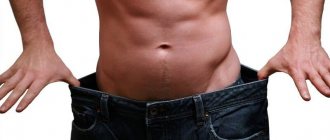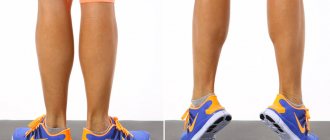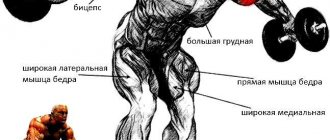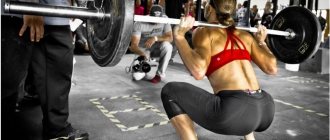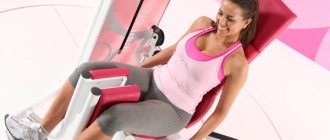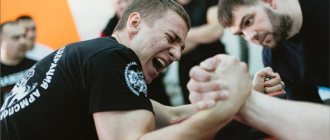What muscles does standing calf raise work?
The main muscles worked when raising your toes will be:
- Calf. Consists of two heads: lateral (external) and medial (internal). They are involved in flexion of the knee joint and foot.
- Soleus. Lies under the calf. Responsible for stabilizing the lower leg and flexing the foot.
If we perform this lift with a dumbbell or in a machine. Then the stabilizer muscles will additionally work.
- Core muscles (abs)
- Back extensors
- Thigh muscles
- Gluteal (large, small and medium).
All these muscles will be responsible for the level position of our body.
Nuances to consider
To make standing calf raises more effective, the following aspects should be taken into account when performing them:
- To work this muscle group, you will need to perform from 3 to 5 approaches, which include 15-20 repetitions.
- It is recommended to use a medium weight, because if you overload yourself, it will be impossible to do a sufficient number of repetitions, and this is what determines the effectiveness of the exercise. But underweight will not load the muscles as much as necessary.
- Make sure that your back does not arch, and that your shoulders, pelvis and heels remain in line. Also, the head should not “nod”. All movements are concentrated in the ankle area.
- The muscles will receive an even greater load if the amplitude is maximum. You should strive to lower your heels as low as possible and raise your heels as high as possible.
- It is important to monitor proper breathing; if you forget about it, it will be more difficult to keep your spine straight.
- In order not to damage the tendons, it is necessary to lower smoothly, and the heavier the load, the more careful the downward movements should be. Lifting up can be more powerful and even sharp, the main thing is to tighten the lower leg muscles more strongly.
- Take a short break every time you reach the highest point. This stop creates additional stress.
- It is not necessary to linger at the bottom, but it can be done if at the same time you want to stretch your muscles. You shouldn't stop at the bottom if you're training with heavy weights.
Advantages and disadvantages
Advantages
- Drawing the calf muscles and increasing their volume.
- Calf and Achilles tendon strains (especially when working full range of motion). Which gives us the opportunity to more technically correctly perform BAR SQUATS or LEG PRESS.
- Improved foot stabilization. Allows you to take more weight when performing basic exercises.
- Great variability in performing lifts allows you to work with any weight. This will give us the opportunity to diversify the training and load the lower leg muscles a little differently.
- Increases endurance of the calf muscles. Consequently, they are less tired while walking or running.
- The development of the calf muscles gives the overall shape of the legs. It's like the icing on the cake.
As you can see, by doing just one exercise on the calves, we can raise our
Flaws
Calf raises do not have any disadvantages as such. Movement is natural for us and meets all biomechanical requirements. Of course, there are a number of contraindications. These are all kinds of leg injuries or varicose veins. If you have such problems, it is best to consult a doctor.
The essence and benefits of the exercise
This exercise is your No. 1 weapon in the fight for a voluminous shin. It can be done in many variations: with dumbbells, with a barbell on your shoulders, in a Smith or a special machine. Of course, there is a difference, but we will talk about it a little later. All other exercises for the calf muscles are essentially derivatives of standing calf raises. By training your calves on a leg press machine, you are exactly replicating the biomechanics of standing calf raises on a machine. The only difference is the absence of axial load on the spine. An exercise from the golden era of bodybuilding, the “donkey” is essentially the same standing calf raise, but due to the forward lean of the body, the load is slightly different.
Benefits of exercise
It is enough to perform standing calf raises once a week, for example, at the end of a leg workout. This will be quite enough for their hypertrophy.
Don't forget that the calf muscles act as stabilizers during compound exercises like deadlifts and front squats. The stronger your stabilizer muscles, the more weight you can lift. Therefore, calves should be trained not only by those who want to have beautiful muscular lower legs, but also by those athletes who set a goal to increase working weights in basic movements. All experienced powerlifters and CrossFit athletes find time in their training schedule to train their calves.
Contraindications for implementation
This exercise places a lot of stress on the hamstrings. For those who have already had problems with it, for example, from front squats, it is not recommended.
Also in this exercise there is a slight axial load on the spine, especially for variations with a barbell on the shoulders, in Smith and in the machine. How big it is depends on the working weight. It is not recommended to use heavy weights for this exercise, as this will make it more difficult for you to focus on working your calves. But if problems with the spine are really serious (hernias and protrusions in the cervical spine, severe kyphosis or osteochondrosis), it is better to train your calves in a leg press machine. The biomechanics of movement are almost the same, but you will protect your back from unwanted stress.
Standing calf raises in the machine
This simulator is very simple in design. It consists of a platform where the toes of the feet are placed. And a lever with two soft pillows into which we rest our shoulders. The weight is changed by moving the limiter. That is, we select the required number of blocks and install it there. When doing lifts in the simulator, we don’t have to worry about stability. Since, thanks to the emphasis on the pillows, we fix the position of the body. You can also work in full amplitude, due to the fact that the feet are on a hill. And at the lowest point, it is possible to lower the heels as low as possible, thereby stretching the triceps surae muscle. But it is worth considering one fact. Since the weight presses from above, the load on the spine increases! Therefore, you should not take very heavy weight.
Execution technique
Initial position:
- Place the lever just below your shoulders.
- Bend over and place soft pillows on your shoulders.
- Stand on the platform with the tips of your feet. Feet hip-width apart.
- Straighten up, thereby removing the lever from the locking device.
- Place your hands on special handles located at shoulder level.
Performance:
- From the lower position, we exhale and stand on our toes, contracting the triceps surae muscle as much as possible.
- As you exhale, we lower ourselves down to the starting position and exhale.
Important:
When working at full amplitude, when your heels drop below parallel, you should not take too much weight. To avoid injury to the calf muscles and Achilles tendon.
Standing calf raise with dumbbells
This option can be performed with both legs at once, or with each leg separately. Unlike the simulator, we hold the weights in our lowered hands. Consequently, the load on the spine is reduced. But you should understand that not everyone can hold heavy dumbbells for a long time. Therefore, increasing the working weight in this option is much problematic. But we can reduce the imbalance in the development of each of the lower leg muscles. And give them a more prominent look. In order to get maximum results, we need to stand on some kind of hill. A step platform is perfect for this. This is done so that we can lower our heels below parallel with the floor and stretch the muscles as much as possible.
Execution technique
Initial position:
- We install the step platform.
- We take one or two dumbbells in our hands.
- We stand on the platform with our toes.
- When performing alternately, we take the dumbbell in the opposite hand of the working leg. That is, if we perform it with the left side, then we hold the dumbbell on the right. And with your free hand you can hold on to something for greater stability.
Performance:
- As you exhale, stand on your toes(toes), fully contracting your calves(calves).
- After a short pause, we slowly lower ourselves to the starting position.
You can work in both full and partial amplitude. The main thing is not to forget to select the correct working weight for each option.
Standing calf raises using a Smith machine
But this version is for people who do not have a special trainer for pumping up their calves. Working at Smith, we don't have to worry about sustainability. Since the rod is fixed in it and moves only along a given vector. In order to get maximum results, you need to put something under your feet. But the step platform will no longer work. She's too tall. And the range of motion of the bar in Smith will not allow us to fully straighten. Therefore, it is better to use plinths. Basically, they are placed under the barbell to perform DEADLIFT. If they are not there, then use pancakes.
Execution technique
Initial position:
- Set the bar of the machine to a height just below your shoulders.
- Climb under it and place it on the top of the trapezoid.
- Stand on the plinths or plates with your toes.
- Lower your heels as far as possible in order to stretch the calf and soleus muscles.
- Keep your back straight, with a natural arch in your lower back. The gaze is directed forward.
Performance:
- As you exhale, stand on your toes, contracting the muscles of your lower leg.
- While inhaling, we return to the starting position.
As you can see, all the options are very similar to each other. But at the same time, if you vary them, you can dilute your workouts a little. And in the case of dumbbells, work on each calf separately.
Varieties of exercise
There are several ways to perform the exercise, for which you will need a simulator or additional sports equipment.
Standing calf raise in the machine
The most common variation is standing calf raises in a machine. Nowadays there is a calf machine in almost every gym. Its main advantage is that it is convenient for us to stretch the muscles at the lower point of the amplitude, since there is still enough distance between the floor and the platform for the feet.
- The starting position for performing the exercise is to stand on the platform with just the toes of your feet, lower your heels down and try to make them “sink” as much as possible. Do you feel a stretch in your calves? So everything is correct. This is our starting point, every repetition needs to be brought to this point.
- At the lowest point, we pause for a few seconds to further stretch the calf muscles. The exercise is performed in the maximum possible amplitude.
- Then we rise again on our toes, while trying to rise as high as possible.
- At the top we do a peak contraction.
© Makatserchyk — stock.adobe.com
How long you need to linger depends only on how long you are able to “squeeze” the calf muscles as much as possible, overcoming the pain.
If you can hold the peak contraction for 3-4 seconds, that’s very good. After 6-8 repetitions in this mode, you will feel a strong pump. After another 5 – severe pain. Our task is to continue working until complete failure. When you can no longer do the maximum stretch and peak contraction, do a few more partial repetitions to finally finish off the muscles. This does not apply not only to standing calf raises in a machine, but also to other variations of this exercise.
If you do not have such a simulator, you can perform the hack exercise:
© Makatserchyk — stock.adobe.com
Another option is Smith, here the barbell can be held on the trapezius (as with squats) or in outstretched arms:
© Makatserchyk — stock.adobe.com
Standing calf raise with barbell
If your gym doesn't have a calf machine, you can do standing calf raises with a barbell or Smith calf raises. To fully simulate the work in the simulator, it is recommended to place a small platform on the floor of the sock to increase the range of motion and stretch the calves in the lower part. If you don’t do this, you will immediately deprive yourself of half the benefits of this exercise, since the load on your calves will be inadequate.
It is recommended not to overdo it with the working weight; here it is important for us to feel the muscles working, and not just lift kilograms.
Tips for maximum efficiency
- The calves are very strong muscles. Therefore, to perform the exercise, you need to use a lot of weight.
- There is an opinion that if we spread our heels to the sides, we will put more stress on the medial head of the gastrocnemius. And if we bring them together, then lateral. But if you delve deeper into biomechanics. We can then conclude that this opinion is erroneous.
- Try to work at full amplitude. But don't forget about the weight of the burden.
- At the top phase of the exercise, when you are standing on your toes, take a short break. This will give your muscles the opportunity to work under static tension.
- Your movements should be completely under your control. Do not jerk or lower the weight by inertia. This can lead to sprains.
- Don't round your back, especially when the weight is on your shoulders.
- Be sure to do a warm-up set before lifting heavy weights.
- The calf muscles are very durable. Therefore, in order to get results when training them, you need to use a medium repetition range. Approximately 12-15 times per set.
Don't forget to exercise your calf muscles. Developing them will help you progress in your training. Thanks to this, you can achieve outstanding results in building an ideal body.
Good luck to everyone in your training!
The importance of warming up
The first thing you need to do is find out how to pump up your calf muscles, but in such a way as not to harm your health. For safe training, before each lesson you should
do a warm-up. This simple procedure will increase blood flow, increase the elasticity of the ligaments and increase the production of synovial fluid, which acts as a lubricant for the joints. In this case, stretching exercises can serve as a warm-up. Prepared muscles will subsequently recover faster after exercise.
INITIAL POSITION
Stand in a special exercise machine, the top of your shoulders and trapezius rest on soft supports, your legs are slightly narrower than shoulder width and slightly bent at the knee joint, place the front of your foot on the base, your heel must be suspended, your back is straight, your abdominal muscles are tense.
For convenience, place your hands on the upper levers on which the shoulder supports are attached, this way you will better fix your torso before moving.
Common mistakes
It would seem that what could be done wrong in such a simple exercise, however, there are mistakes here too. First of all, this is the wrong position of the socks. They look outward, like those of ballet dancers, or are tucked inward, like those of a clubfooted bear, but should be exclusively forward.
In addition, when raising on their toes, many people move their heels closer to each other - this makes it easier to perform. There is no need to do this either. The key to growth is clean technology!
Another typical mistake is when the legs “flop” on the floor under the influence of the barbell pressing on them. You must lower them under control, resisting the weight. Remember: it is in the negative phase of the movement, when lowering the weight, that the most muscle fibers are damaged. But in order for them to hypertrophy, they need to tear and recover - a wise body makes them stronger so that they can withstand the load next time.
If you “plop” your heels on the floor with relief, consider that the exercise was done in vain. The soleus muscle is small, you spent very little energy, and you did not achieve muscle growth.
Training skinny legs
For too thin legs, you can add the following exercise to other exercises, which will help you gain the necessary muscle mass by training at home.
Standing straight and lowering your hands down, you need to raise your toes, remaining standing only on your heels. We smoothly shift the weight and stand on our toes. Then we repeat this movement only on one leg, then on the other. This exercise is performed about 15 times for each approach. This is done three times. You can take dumbbells in your hands.
Useful tips
In addition to exercises that allow you to make your calves smaller, it’s a good idea to listen to the advice given by experienced athletes.
- If you play sports in equipped gyms and at the same time strive for slimmer and toned legs, it would be better not to put a lot of stress on them. Pumped calves look voluminous.
- If you want to reduce the volume of your shins, it is better to pay special attention to stretching them. Sports such as Pilates, gymnastics or yoga give similar results.
- Aerobic exercise and jumping rope will also help tone your calf muscles.
- Also, home exercises for losing weight in your legs will be more effective if you control your diet. It is not necessary to resort to radical changes in your diet, but it is advisable to adjust your habits. You need to think through the menu for the day to make it balanced, and also not allow yourself to eat at night.
- The main rule is to strive for regularity and follow the correct technique when performing exercises. Following this advice, within a month you can notice changes for the better.
What is the effectiveness of the exercise?
The exercise is a type of isolation exercise, as it involves a specific muscle group - the calf muscles.
When performing, the following muscle groups are actively involved:
- caviar;
- soleus;
- trapezoidal;
- gluteus minimus and medius.
The benefits of the exercise are:
- development of strength endurance of the legs;
- increased muscle mass in the calf and lower leg;
- increased muscle tone;
- improving the aesthetic appearance of caviar;
- losing weight, burning fat, eliminating the “bloat” effect;
- development of coordination and sense of balance;
- preventing the risk of tendon damage.
Calf raises perfectly develop the ability to jump, which with regular training increases to 30 cm. The advantage of calf raises is considered to be the absence of impact on the knee joint when performing and lifting large weights. The exercise easily allows you to regulate the load on the muscles by using weights in the form of a barbell or dumbbells.
More about calf muscle training >>
